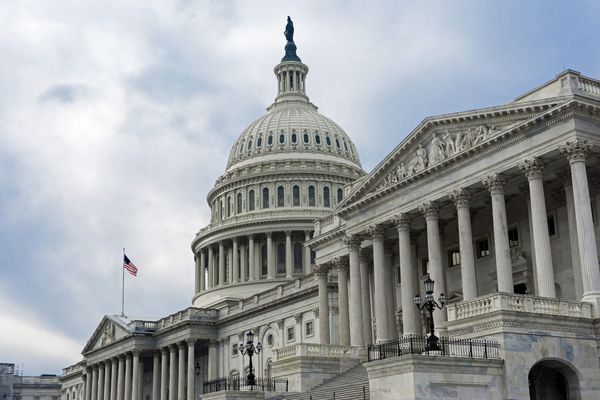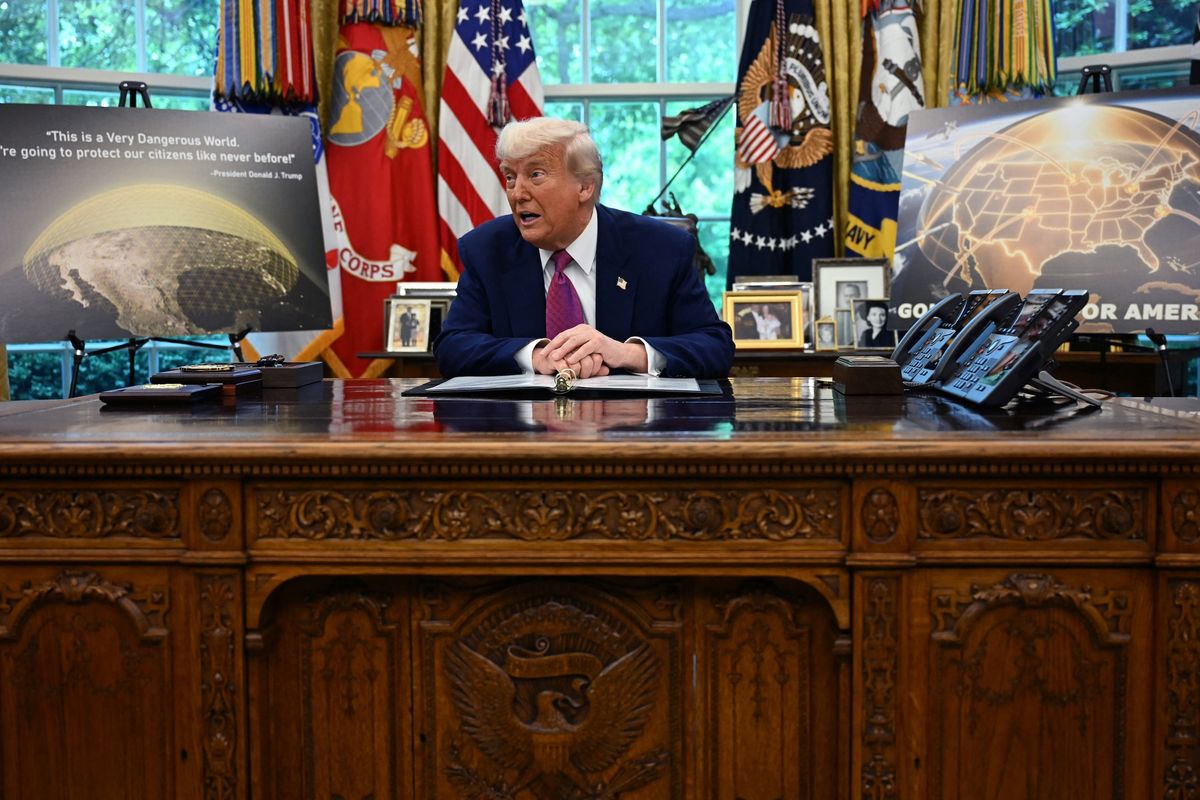OPINION — On the morning of Tuesday, July 7, FBI Director Christopher Wray told a Hudson Institute audience, “The greatest long-term threat to our nation’s information and intellectual property, and to our economic vitality, is the counterintelligence and economic espionage threat from China.”
To support his point, Wray said he would present “more detail on the Chinese threat than the FBI has ever presented in an open forum.” He said, for example, that some 2,500 active FBI counterintelligence cases then underway were “related to China.”
They represented half of all FBI counterintelligence cases nationwide, Wray said, adding, “The FBI is opening a new China-related counterintelligence case about every 10 hours.”
Just five hours later, that same afternoon, Defense Secretary Mark T. Esper posted a 10-minute video on the Pentagon website reviewing his first year in office in which he said, “We are now in an era of Great Power Competition; and that China, then Russia, constitute our top strategic competitors.”
Esper went on, “One of our top ten goals – the priority that drives and underlies many of our efforts today – is to focus the [Defense] Department on China.” He spoke of establishing a China Strategy Management Group, but more interesting was that he called attention to his directing the National Defense University “to refocus its curriculum by dedicating 50 percent of the coursework to the PRC (People’s Republic of China), and I tasked the Military Departments and Services to make China the pacing threat in all of our schools, programs, and training.”
Last Tuesday’s public focus on China by Wray and Esper was just one day in what appears to be a major PR campaign by the Trump administration to publicly emphasize its view of the threat to the U.S. from China. It reminds me of 2002, and the Bush administration’s summer-through-fall public relations campaign that built up the threat from Iraq’s leader Saddam Hussein based on his allegedly having weapons of mass destruction.
Kickoff of this White House-directed campaign seems to have come when Trump National Security Adviser Robert O’Brien gave a June 24 speech before the Arizona Commerce Authority. O’Brien spoke at length about what he called, “The challenge the Chinese Communist Party poses to the United States and our allies.” He said his remarks “are the first of several speeches senior Administration officials will give on this matter over the next few weeks. You will soon hear from Secretary of State Pompeo, Attorney General (William) Barr, and FBI Director Chris Wray on the subject.”
Wray, at the Hudson Institute talk last week, also promoted what is still to come. He said, “This [Chinese] threat is so significant that the Attorney General and the Secretary of State will also be addressing these issues in the next three weeks.”
What’s interesting about the speechmaking is that other than O’Brien saying, “The Party General Secretary Xi Jinping sees himself as Josef Stalin’s successor,” almost no one mentions the Chinese leader, whom Trump has repeatedly called a friend. Most often the danger from the Chinese side, according to these Trump officials, comes from “Chinese Communist Party’s actions,” as O’Brien put it, or “China’s government and Communist Party,” as Wray said.
O’Brien penned an op-ed in Monday’s Washington Post describing China’s “horrifying repression of the Uighurs,” but again it is the Chinese Communist Party and its leaders that are the villains and Trump’s friend Xi, is never mentioned.
Adding to the anti-China attitude is Trump’s own repeated accusations that the Chinese hid facts about the virus and the President continues to refer to it as the ‘Wuhan virus’ or ‘Kung flu’.
Trump’s senior White House advisor Peter Navarro took the flu linkage one level higher during a July 9, interview with PBS NewsHour.
Navarro claimed that one reason the U.S. had so many Covid-19 cases was that China “sent thousands of Chinese nationals on aircraft, which many of them were infected…then spread the seed of that virus. So, that's part of the problem we're facing now.” He offered no proof.
What’s potentially dangerous in this Trump administration buildup of the Chinese threat, along with China being the believed source of Covid-19, is it’s taking place at the same time Chinese and U.S. navy and air elements are carrying out sequential military exercises in the South China Sea while each side is claiming the other is increasing tensions.
On June 27, China announced it was planning annually scheduled maritime exercises off the Paracel Islands, from July 1-5. The Paracels, which the Chinese call the Xisha Islands, are in contested waters. The Chinese said their activity was “boosting the Chinese military’s maritime defense capability.” U.S. analysts guessed it looked like an amphibious landing and island seizure operation because of the presence of a large Chinese Coast Guard vessel in the area.
The Global Times, the Beijing government’s official English-language newspaper, recently said among the Chinese Navy vessels participating in the exercises was its latest guided-missile destroyer, Zibo, making its first public appearance.
After the Chinese exercise had begun, the Pentagon on July 2, released a statement that said, “Conducting military exercises over disputed territory in the South China Sea is counterproductive to efforts at easing tensions and maintaining stability. The PRC’s actions will further destabilize the situation in the South China Sea.” The statement added, “We urge all parties to exercise restraint and not undertake military activities that might aggravate disputes in the South China Sea.”
However, two days later, on July 4 – one day before the Chinese exercise ended — the U.S. Navy aircraft carriers USS Ronald Reagan and USS Nimitz, plus elements of their strike groups, sailed from the Philippine Sea into the South China Sea. They then held the first American, dual-carrier military drills since 2014, near the same Paracel Islands where the Chinese had been active.
Pacific Command put out a press release July 7, that said, “The Nimitz and Ronald Reagan strike groups conducted several exercises and operations to strengthen warfighting readiness and proficiency in an all-domain environment. Integrated operations included air defense exercises, tactical maneuvering drills, simulated long-range maritime strike scenarios, and coordinated air and surface exercises to maintain combat readiness and maritime superiority.”
One element of the U.S. exercise saw a B-52 bomber from the 96th Bomb Squadron, Barksdale Air Force Base, Louisiana, participating in a 28-hour mission. It flew from Louisiana to the South China Sea where it joined a maritime integration exercise with aircraft from the two carrier strike groups and then landed at Andersen Air Force Base, Guam.
“Bomber Task Force demonstrates U.S. capability to rapidly deploy to a forward operating base and execute long-range strike missions,” said Lt. Col. Christopher Duff, 96th Bomb Squadron commander.
Whereas the Pentagon had said the earlier Chinese maritime exercise was “counterproductive” and could “destabilize” the situation, Pacific Command described participation of Strategic Command’s B-52 bomber as among “efforts to help maintain global stability and security” and “support the National Defense Strategy’s objectives of strategic predictability and operational unpredictability.”
The Chinese last Thursday, claimed that during the American exercises, five U.S. military reconnaissance aircraft flew close to South China's coastal Guangdong Province, a tactic used by nations to test another country’s air defensive systems. In response, the Chinese People's Liberation Army in succeeding days began holding mock air defense battles in that coastal region, according to the July 9, Global Times.
Meanwhile, an analyst in Sunday’s Global Times, said, “The existing [Chinese] crisis management mechanisms are becoming strained because of the higher frequency of unpleasant encounters.”
If verbal exchanges and military matters don’t come under control, it may be just a matter of time before a serious event occurs.
Read more expert-driven national security insight, perspective and analysis in The Cipher Brief














